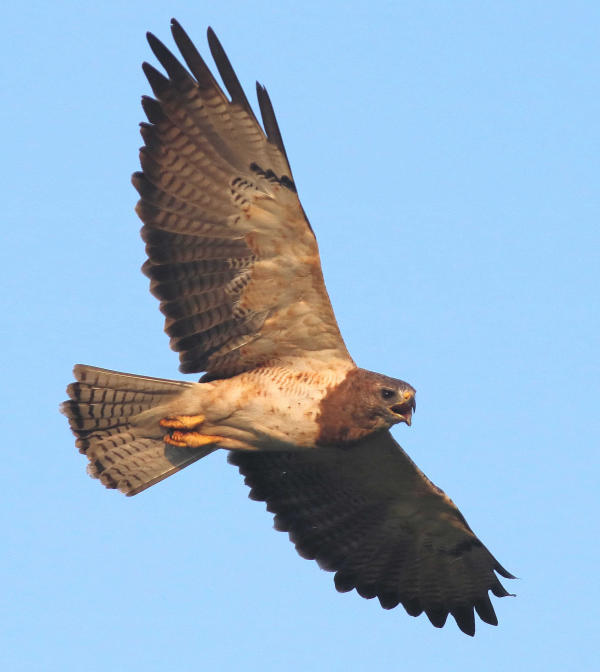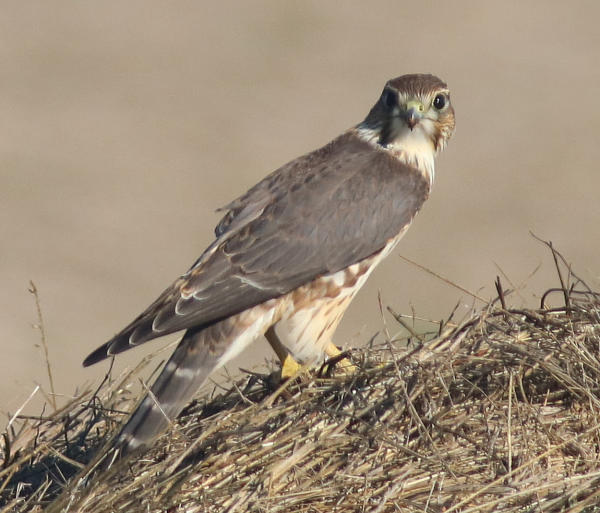
A vocal adult Swainson’s Hawk in flight enlivens the Dakota sky.

A surprise immature Merlin.
|
Many birders are habitual listers; that is, they keep lists of the birds they see during their birding trips. Some birders keep simple lists of all the species they see. Others keep more detailed records that include counts of all the birds they see and, when possible, they include birds’ age, sex and other characteristics. All bird lists should include some simple information including your birding location, date, time and weather conditions; and some birders like to include relevant photos of birds and images of landscapes or habitats. Many birders keep dated lists of the birds that visit their feeding station, and keeping “yard lists” is popular, along with any number of other specialized lists – city lists, favorite site lists, refuge lists, county lists, state lists, life lists – you get the idea.
My most recent lists of birds were specialized in that I kept track of a focused group of birds – birds of prey – during two birding drives I took last week. Wednesday provided a beautiful sunny windless day for a field trip west to my eventual destination of Bismarck, my hometown. My primary interest was to check the pulse of the raptor migration as I drove west across the Missouri Coteau, then I would follow the east side of the Missouri River Valley north.
There was a fun abundance of Red-tailed Hawks spread across the Missouri Coteau and I found one falcon – a male Taiga race Merlin. Many birds migrate along the Missouri River, but there were plenty of Red-tails after the first half of the river segment of the drive, but I was surprised not to see any American Kestrels, or Bald Eagles.
When I reached the capitol city, I added my count of hawks that included 48 Red-tails, of which only three appeared to be recent fledglings. Another two were Krider’s Red-tails, one a recent fledgling. To round out the hawk count, I was surprised to find only two Swainson’s Hawks and one male Northern Harrier across prime habitat for both species. Add the Merlin, and my census included 52 raptors total.
To counter that informal transect census, Thursday I decided to tally the raptors I observed during my local birding drive south of my home. In spite of pretty strong wind (south-southeast at 17 miles per hour) I found good diversity and numbers of birds of prey, as evidenced by my total that included an immature Bald Eagle, two Merlins (a adult male and an immature), three male American Kestrels, five Northern Harriers (three females and two immatures), six Swainson’s Hawks (three adults and three immatures), and 20 Red-tailed Hawks, including seven immatures and two Krider’s – 37 raptors total.
Considering that I drove about one-third the number of miles Thursday as I drove Wednesday suggests my local area attracts more birds of prey, even though the Missouri Coteau of the northern Great Plains is always an impressive raptor region. But that’s an unscientific, but interesting, comparison. One factor that came into play that minimized both raptor counts was the leaf cover; certainly there were other birds of prey that I could not discern among the tree foliage. Also, during the windy day I noticed that some raptors were “grounded,” seemingly avoiding the wind, which probably affected Thursday’s count too.
One side-product of my raptor count was remembering doing similar bird censuses between Bismarck and my present home when I was young, identifying all the birds and keeping a tally of each species. A few years ago I found one of my birding lists from when I was nine years old, which was personally rewarding. Frankly, my census lists don’t look much different today.
It is interesting to note that I have never seen more than one Merlin in one day in this region before, so to find two relatively close to home was exciting. Actually, finding three Merlins in two days is equally impressive. All three were migrating Taiga race Merlins. In the field I thought one of the Merlins might belong to the lighter-colored Richardson’s (prairie) race, and I managed to take a few photos of the fairly close mini-falcon while it stood atop a grass bale. Closer inspection of the photo indicated this Merlin was an immature male Taiga; a beauty nonetheless (see photo).
So during these two field trips, I collected a lot of information about birds of prey in a region rarely visited by other birders. Is it valuable information? Sure, at some level it can add information to existing reports; but what do I do with it? The best plan is to record your sightings in eBird, a citizen science project of the Cornell Lab of Ornithology. And that’s the topic of next week’s Birding Lifestyles article. In the meantime, enjoy your mid-September birding experiences!
Article and photographs by Paul Konrad
Share your birding experiences and photos at editorstbw2@gmail.com